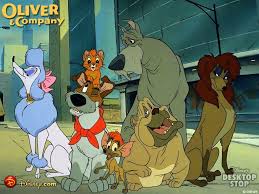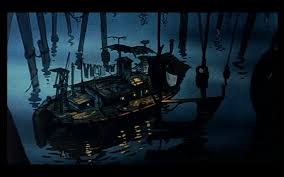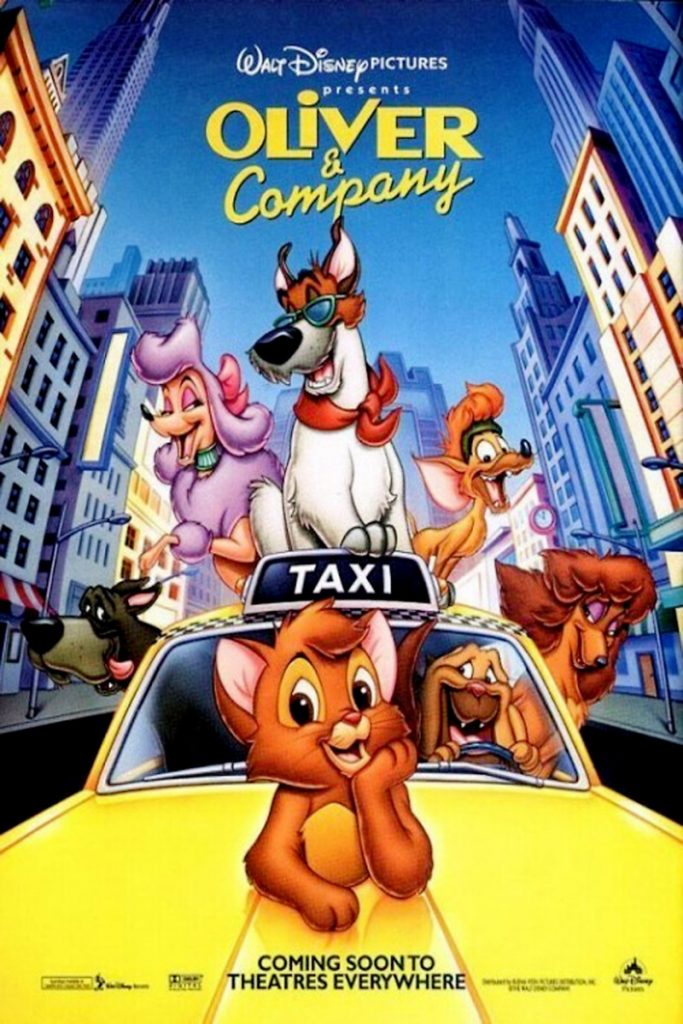Let’s be honest, most of us will agree that stories can always be improved by the addition of a few adorable animals. It’s understandable then that Disney chose to recreate the classic tale of Oliver Twist using a whole host of cute and quirky quadrupeds in their 1988 animation Oliver and Company. Drawing on its Dickensian inspiration, the film follows the protagonist – and adorable kitten – Oliver through the streets of New York, where he encounters a hard- knock gang of dogs and their impoverished owner living on the edge of their community. Adopted by Jenny, who has been similarly abandoned in her parents’ absence, Oliver finds comfort at last. However, when his street-smart companions mistake his re-homing for a kidnapping and come to his rescue, both Oliver and Jenny become endangered, and Oliver must balance his two loyalties to find a home.
Oliver and Company is not the first attempt that has been made to soften the heavy themes of loneliness and isolation that originate in Oliver Twist; the 1968 musical adaptation Oliver! created a ‘happy, melodious world which both children and adults could appreciate’ [1] to set the scene for Scribner’s family-appropriate version. Both adaptations use music to aid the story in its appeal to children by capturing their attention and providing relief from otherwise sad tones.
Told through the overarching medium of traditional 2-D animation, Oliver and Company adheres to the generic conventions of a family film through its use of the trope of the ‘orphan’ and quest for family or community. The anthropomorphised storyline of Oliver’s coming of age, through the traversal of social boundaries, functions as an allegory on class distinction and human stereotypes in New York. There are several hierarchies within Oliver: that in which Oliver is the only feline in the film, both young and vulnerable, and is therefore subordinate, the canine world in which not all dogs are equal, the human-canine relationship in which animals exist between the dichotomy of pets and pests, and the human world of New York.
That the film is set in New York is key to an analysis of class dynamics in Oliver because an environment where characters of different socio-economic backgrounds can interact is essential. As depicted in the promotional image above, each of the main canine characters are anthropomorphised and styled into different breeds. Two oppositional characters for example are Dodger, the ‘mutt’ with patchy grey fur, a make-shift bandana scarf, and a thick New York accent, and Georgette, the well-bred and well-groomed poodle that speaks with an upper-class American accent. Even in the animal world, there are some animals that are associated with high-life, and some that are associated with the streets. It is important to note the use of pedigree breeds versus mongrel breeds because they are powerful social indicators. According to Clinton R. Sanders, ‘The type and temperament of the companion animal one chooses and the instrumental purpose for which it is bred are other aspects of identity symbolization.’ [2] By this he means that it is not only the possession of a pet that indicates a certain socioeconomic status since ‘they are relatively expensive to acquire and maintain’, [3] but also that the breed of pet chosen is a reflection of one’s personality. He uses Rottweilers as an example of a breed that might project an aggressive personality for the owner. This is reflected through the Rottweilers in the film, who represent the threat Sykes poses to Fagin and his group. Georgette is another example of how pet-breeds reflect their owners. As a pedigree poodle, Georgette is a highly styled breed that is associated with aesthetic perfection. In this way, she illustrates her owners’ desire for a positive social identity. It is because Georgette is so firmly placed within the upper social class that it would be so unlikely for her to meet the rest of the characters if not for the parameters set out in the film – that it is set in New York, as mentioned, or without Oliver functioning as the in-between that brings the different characters into the same dynamic.
Fagin’s gang is introduced in images of a dark-blue colour scheme, uninviting and cold. Zooming in on an abandoned and dishevelled boat emphasises that this scene is leading the audience down into the underbelly of the city, emphasising the space as one of poverty. Two characters that are directly juxtaposed through their possession of particularly human hobbies during this introduction are Francis and Tito. Francis is a British Bulldog of a somewhat more educated background than the others so far as we are made aware, which is illustrated as he rehearses the lines ‘Tomorrow and tomorrow and tomorrow…’, taken from Macbeth in front of the static-ridden television. The monologue in question is one of the most famous from the play; Shakespeare comments on the slow passing of time, using the metaphors ‘life’s but a walking shadow […] a poor player’ [4] to imply that life is disappointing; life drags, and it doesn’t even amount to much in the end. Francis’ recitation of these lines reflects the idea that a member of the under-classes may work their entire lives and never achieve satisfaction. Indeed the fact that his rendition is cut short by Tito suggests that despite any ambition they may possess, the fates of these characters are destined to fall short.
Tito on the other hand is an excitable Chihuahua who has no interest in Shakespearean drama. Instead, Tito dances to salsa music, jumps in front of the screen, and pleads to Francis, ‘let’s watch some boxing’. He also has a heavy Latin accent. Tito’s function in the film is to provide an allegory of how ethnicity might interact with social classification. For example, Tito is referred to as a ‘rodent’ by Francis, implying that hierarchically, Tito is of a breed inferior to his own: a breed that is considered an unwanted pest. This is a subtle yet comedic invitation for the audience to consider why one individual is inherently more intelligent, and more valued, than the other. Yet the fact that Tito is also a character tied up within the comedic elements of the film, as exemplified when he becomes the subject of physical comedy, mockery, and even electrocution, suggests a purposeful presentation of his character as one that does not need to be taken seriously. Richard M. Stephenson labels this ‘stratification humour’ and writes, ‘there is a general propensity to ridicule the top and bottom of the status hierarchy’ in American humour. He goes on to explain that ‘it is selective even at these extremes’, [5] meaning that of the lower social rung, it is ethnic minorities that are often targeted. Tito’s confinement to a comedic role is therefore representative of a larger issue in society – that comedy is used to undermine already oppressed minorities, when it is their voices more than any that should be listened to.
In contrast to Tito, Georgette represents a household situated at the opposite end of the social spectrum. This is a world that is decorated in soft pinks and pastels, usually tinged with warm yellow glow. Unlike the spaces of poverty inhabited by other characters, these are environments filled with energy. The merging of these two worlds however is awkward and largely unsuccessful. For example, Tito’s transition into the household begins as he and Georgette dance together to the Salsa music that has also made its transition into the new space. While at first impression this suggests a possibility for social mobility in the joining of both Fagin’s gang and Jenny’s household, it is consequently revealed that this is only possible through Georgette’s condition that Tito commit to ‘a little grooming’ – that he be modified to fit the lifestyle. In fact, her assertion that Tito is ‘not so bad for a little bug-eyed creep’ reminds the audience that Tito and the gang are still considered the unappealing ‘other’. Paul Wells describes this effect as ‘a substitute resolution that speaks to the ethical necessity of family entertainment’, [6] by which he means that in order to avoid an uncomfortable discourse surrounding the real discourse of a text, the audience is provided with a simpler satisfaction that caters to the family-friendly nature it desires. Therefore rather than a new social environment in which class distinctions become unimportant, or even non-existent, Oliver offers a scenario in which social parameters still dictate the relationships of the characters, but under the pretence of a resolution through their apparent satisfaction. This is made even clearer in the fact that the gang’s invitation into this world of privilege is quietly assumed to be over at the announcement of the return of Jenny’s parents. This is a scenario not so altered from the one before it; the poorer or lower classes are still shameful, and are better off hidden out of sight.
Overall, Oliver discusses large problematic themes such as racial discrimination and poverty, for example in the implication that minorities such as Mexican or Puerto- Rican Americans are not only confined to the lower rungs of the social hierarchy but are also devalued by those they share it with. Moreover, these interactions suggest a body of knowledge (which is of course erroneous) in which social minorities do not possess intellectual capacity equal to that of their counterparts. Marc Napolitano writes, ‘it is obvious that the Dickensian elements of the film were of little importance to the creators’, [7] and while it is true that a particularly avid audience may find themselves encouraged by the film to reassess the way they read class division, the film is limited in its capacity for deep engagement. Tito’s existence as a source of comedy, for example, furthers his existence as a representation of minorities in society that pursue more equal and serious consideration in terms of the stereotypes and persecution they face. Moreover, the absence of a solution to the imbalance between Oliver’s two loyalties – the compulsion for the gang to leave in order for the world to be put to rights – suggests that this film steers away from a frank discussion on the effects of class and towards satisfying itself with the comfort of our main character, Oliver.
In terms of hierarchy and social structure being key themes, analysis of Oliver and Company reminds me of another animated favourite – The Lion King (Allers and Minkoff, 1994). Released sixteen years later, Allers and Minkoff offer another allegorical community of anthropomorphised animals, this time as a re-imagination of Hamlet. Like Oliver and Company, The Lion King offers an allegory of social minorities – ethnic, economic, and mentally handicapped – namely through the representation of Scar’s hyena workers. Furthermore, it explores a society organised by capitalist values, as Mufasa demonstrates in his insistence that all creatures play a role in the ‘circle of life’. The film also undermines communist values in the overthrowing of a dictatorship that has run the society into the ground in favour of the restoration of the King. In contrast to Oliver, The Lion King provides a much richer reading for society because it presents a wider community. While still remaining firmly within the genre of a light-hearted family animation, The Lion King approaches themes such as poverty, discrimination and injustice with a heavier hand than Oliver and Company, just as they should be dealt with in our own society.
[1] Marc Napolitano, ‘Disneyfying Dickens: “Oliver and Company” and “The Muppet Christmas Carol” as Dickensian Musicals’, Studies in Popular Culture, Volume 32 (2009) http://www.jstor.org/stable/23416184?seq=10#page_scan_tab_contents [accessed 24th November 2015] p.80
[2] Clinton R. Sanders, ‘The Animal ‘Other’: Self Definition, Social Identity and Companion Animals’, Association for Consumer Research (1990) http://www.acrwebsite.org/search/view-conference-proceedings.aspx?Id=7082 [accessed 22nd January 2016] para.8
[3] (Sanders, para.7)
[4] William Shakespeare, ‘Speech: “Tomorrow and Tomorrow and Tomorrow”, The Poetry Foundation < http://www.poetryfoundation.org/poem/247636 [accessed 24th November 2015]
[5] Richard M. Stephenson, ‘Conflict and Control Functions of Humour’, American Journal of Sociology, Volume 56 (1951) http://www.jstor.org.eresources.shef.ac.uk [accessed 22nd January 2016] p.571
[6] Paul Wells, The Animated Bestiary: Animals, Cartoons, and Culture, (Rutgers University Press, 2009) p.21
[7] Marc Napolitano, ‘Disneyfying Dickens: “Oliver and Company” and “The Muppet Christmas Carol” as Dickensian Musicals’, Studies in Popular Culture, Volume 32 (2009) http://www.jstor.org/stable/23416184?seq=10#page_scan_tab_contents [accessed 24th November 2015] p.88



